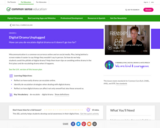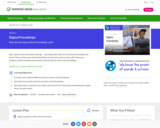
For training purposes only - NOT intended for instructional use
- Subject:
- 21st Century Skills
- Material Type:
- Diagram/Illustration
- Author:
- Roger Minier is the author of modificatins to this document for purposes of testing
- Date Added:
- 11/05/2019

For training purposes only - NOT intended for instructional use

This lesson teaches students the Empathy and Define phases of the Design Thinking process using Empathy Interviews and Empathy Maps. Students need assigned partners to complete the Activity.
Estimated time required: 1-2 class periods.
Technology required for this lesson: Laptop/Desktop, Tablet.

This lesson introduces students to the basics of the Design Thinking process, complete with a hands-on activity. Get your prototyping materials ready as students design wacky chairs for users from the 1960's!
Estimated time required: 1-2 class periods.
Technology required for this lesson: Laptop/Desktop, Tablet.

In Lesson 2 students will use the Ideate and Prototype phases of the Design Thinking process. Using a bag of prototyping tools, groups of 2-3 will create prototypes to solve problems for scientists aboard the New Horizon.
Estimated time required: 1-2 class periods.
Technology required for this lesson: Laptop/Desktop, Tablet.

In this lesson, we will learn about an amazing design movement from the 1960s: Graphic Design and Pop-Art.
Estimated time required: 1-2 class periods.
Technology required for this lesson: Laptop/Desktop, Tablet.

Contains plans for six or seven lessons that teach students to create and present effective poster presentations. In addition to objectives and standards, this instructional plan contains links to PDF handouts and sites used in the lessons as well as assessment and reflection activities. CCSS.ELA-Literacy.CCRA.SL.5

Why is it important that we have device-free moments in our lives? Technology use isn't always a distraction, but there are definitely times when it's best to keep devices away. Help students learn when it's appropriate to use technology and when it's not -- and practice making family rules for device-free time at home. Approximately 40 mins.
LESSON OBJECTIVES: Recognize the ways in which digital devices can be distracting. Identify how they feel when others are distracted by their devices. Identify ideal device-free moments for themselves and others.

How can you de-escalate digital drama so it doesn't go too far? Miscommunication is a common occurrence online and on social media. Plus, being behind a screen makes it easier to say things they wouldn't say in person. So how do we help students avoid the pitfalls of digital drama? Help them learn tips on avoiding online drama in the first place and de-escalating drama when it happens. Approximately 45 mins.
LESSON OBJECTIVES: Reflect on how easily drama can escalate online. Identify de-escalation strategies when dealing with digital drama. Reflect on how digital drama can affect not only oneself but also those around us.

How do you keep online friendships safe? Kids make friends everywhere they go -- including online. But are all of these friendships the same? How can kids start online friendships and also learn ways to stay safe? Help your students understand both the benefits and the risks of online-only friendships. Approximately 45 mins.
LESSON OBJECTIVES: Compare and contrast different kinds of online-only friendships. Describe the benefits and risks of online-only friendships. Describe how to respond to an online-only friend if the friend asks something that makes them uncomfortable.

In this lesson students will create digital graphics using a free software called Gravit. In the activity, students will use Graphic Design principles to visually represent a common word using Gravit.
Estimated time required: 1-2 class periods.
Technology required for this lesson: Design Software, Laptop/Desktop, Tablet.

In this lesson, students will learn how to design custom projects in Gravit using paths, shapes, and colors.
Estimated time required: 1-2 class periods.
Technology required for this lesson: Design Software, Laptop/Desktop, Tablet.

In this lesson, students will learn how to manipulate images with filters and cropping, then create their own Surrealist image.
Estimated time required: 1-2 class periods.
Technology required for this lesson: Design Software, Laptop/Desktop, Tablet.

In this lesson, students will learn how graphic designers make advanced designs using compound shapes and gradients. Then, students will apply their skills by designing a 60s era band logo.
Estimated time required: 1-2 class periods.
Technology required for this lesson: Design Software, Laptop/Desktop, Tablet.

Learn how to interpret and evaluate information online, whether you're reading an article, watching a video, or using social media.
Lessons include: (1) Judging Online Information. Use these strategies to judge information you read online. (2) Practice Evaluating a Webpage. Learn how to evaluate a website for credibility and content. (3) How to Read a Webpage. Use these tips for reading a webpage. (4) What is Sponsored Content?. Learn how to identify sponsored content. (5) What is Clickbait?. Learn more about clickbait and how it's used in today's high-tech world. (6) What is Targeted Advertising?. Learn more about how advertisers use targeted ads to try and sell products to Internet users. (7) How Ads and Clicks Shape the Internet. Learn how ads and click shaped the Internet into its current form with this free lesson.

How does digital media try to hook you, and what can you do about it? Sometimes when you're using media, it's hard to stop. Lots of people even say they feel "addicted" to their phones or the apps and games they use. But is digital media actually designed to get you hooked? Have students think about the ways different digital media does -- and does not -- help us find healthy media balance. Approximately 45 mins.
LESSON OBJECTIVES: Explore ways that different digital media are, and aren't, designed to help them make good media choices. Reflect on how digital media is designed to either help or hinder the addition of meaning and value to their lives. Think about how to develop good, healthy habits when using digital media.

Students will use critical thinking, creativity, collaboration, and communication skills to edit photos using the Snapseed digital photo editing app. The app used in this activity is a tool to help students develop a STEM mindset. It is important to allow students to work through the process as independently as possible with the facilitator acting only as a guide.
Estimated time required: 1 class period.
Technology required for this lesson: Laptop/Desktop, Photo Editing Software, Tablet or Smartphone.

This is a google slides presentation that requires students to complete various tasks related to the following topics:
a) web safety
b) website evaluation
c) copyright
d) plagiarism
e) citations
Students then choose one of those topics and produce an artifact that reviews what was learned within the modules. Project choices include a video, podcast or infographic.

During this lesson, students are introduced to the Immersive Media course and meet the course’s narrator: Filos. Filos is from another planet and will introduce students to their first digital storytelling tool: branching narrative stories! Students will explore Filo’s branching narrative story about her home planet, and then create their own story and planet using a free software called Inklewriter.
Estimated time required: 1-2 class periods.
Technology required for this lesson: Design Software, Laptop/Desktop, Tablet.

During this lesson, students will learn more about the Immersive Media course as a whole (but if they are just completing this lesson or unit, that’s perfectly fine too!). Then, students will learn how to using branching narrative software like inklewriter to create “interactive biographies”. Students will create their own “alien” and add a backstory to their life in interactive biography format.
Estimated time required: 1-2 class periods.
Technology required for this lesson: Design Software, Laptop/Desktop, Tablet.

During this lesson, students will learn about the types of technology used to create “immersive” experiences such as 360 cameras, augmented reality, and virtual reality. Students will then design their own “alien” technologies and develop those technologies in an interactive story.
Estimated time required: 1-2 class periods.
Technology required for this lesson: Design Software, Laptop/Desktop, Tablet.